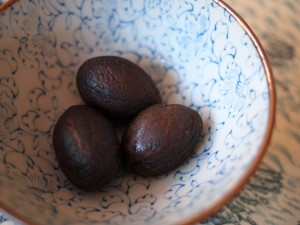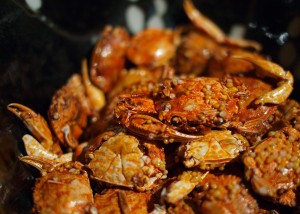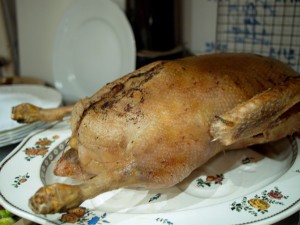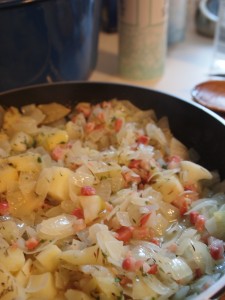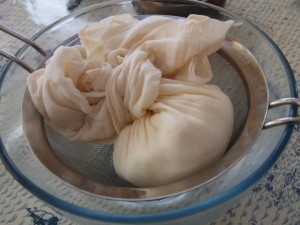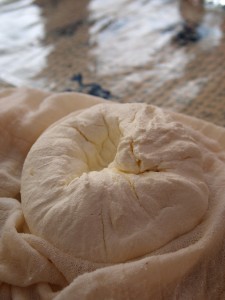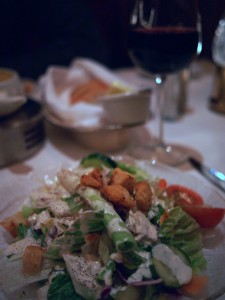
If you follow me on Twitter, you’ll have noticed that I’m in America for a few weeks. I’ve been spending part of the time here skiing up in Lake Tahoe, an alpine lake on the border between Californa and Nevada which Mark Twain called “the fairest picture the whole earth affords”. The clear air and the long blue views up here are good for the soul, but they seem to have a curiously retarding effect on the cooking. Many of the restaurants around the lake have menus which haven’t changed in the six or so years I’ve been coming here, but that’s nothing; there are a good few menus here which don’t look to have changed since the 1960s, when many of the properties here were founded, and Frank Sinatra (who owned the Cal Neva Lodge, a hotel and casino on the north shore) and his pals Marilyn and JFK used to drop in for a steak.
Lew Mar Nel’s, at the Station House Inn in South Lake Tahoe (a note to Best Western, the owners: “The world’s largest hotel chain” is probably one of the worst tag lines you could have chosen), is one of these joints that’s been around since before they filmed the Godfather Part II a few miles up the road. Detective work centred around the drinks menu and the art on the walls (a Vesper and Dirty Martini are called Lewis and Nelson Martinis here, and splodgy oil paintings of vases of flowers on every wall have MARGIT signed assertively at the bottom right) suggest where the name might have come from back in the day, although there’s no trace of Lewis, Margit and Nelson left now besides the cocktails and pictures. The restaurant is built in a log-cabin style, with bare wood walls, a rustic log bar, and benches in the booths covered with a very slightly sticky burgundy velour. It’s all lit with wobbly orangey dimness, so any stains are well hidden. The menu is a historical record of steakhouses long vanished – all Wienerschniztel, peppercorn steaks, trout amandine and escargots – and Glenn Miller’s band warbles softly over the PA system.
This might sound charming, and I’ll admit that I was coerced in by the retro menu, but it is not an unalloyed good thing. You’re paying heftily for the privilege of taking a trip in Tahoe’s equivalent of the Mr Fusion-ised DeLorean, and while a couple of hours channeling your youthful grandmother on a slightly pissed night’s jolly might be a giggle, it’s not necessarily worth the $100+ we paid for a meal and a couple of glasses of wine, especially given the food, which was of a quality that any self-respecting 1960s chef would have drowned himself over in the lake next door.
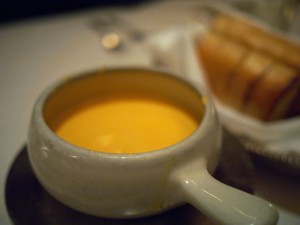
In keeping with the retro nature of what’s on the menu is a retro method of ordering: although there are plenty of appetisers on the menu, you are presented on arrival with a cheese fondue with a hunk of bread – “fresh-baked sourdough”, they say, but it’s actually just a lump of commercial baguette par-baked in a factory somewhere else, and finished off in the kitchen – and a salad with your choice of dressing, whatever your main course choice happens to be, so those appetisers remain unexplored for all but the hungriest. The fondue is made with something the Americans seem to call cheese (at least, our waiter did), but which European visitors, or Americans who are familiar with the output of an actual cow, may balk at. It’s curious stuff; silky in the mouth with a low melting point (lower than that of, say, cheese), very salty, very umami and very rubbery when dripped on something cold and left to congeal. It is the yellow of motorway maintenance men’s jackets, and tastes almost nothing like cheese.
The compulsory salad was a high point; it’s hard to get a salad particularly wrong, and I am a fan of blue cheese dressing, which actually managed to taste cheesier than the nominally cheesy fondue. Garlic croutons appeared to have been made in the kitchen, and there was a certain charm to the moulded pyrex plate it all arrived on (I am a sucker for things which remind me of my Grandma, whose salads were lousy – getting them wrong might be hard, but she made it look effortless thanks to an addiction to Heinz salad cream – and always involved a pyrex plate).
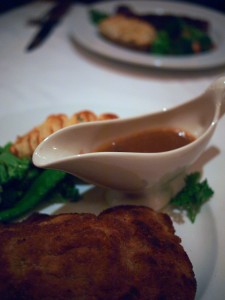
I ordered the veal cordon bleu. When do you ever see a veal cordon bleu on a menu these days? It was overcooked and dry (the cheese and ham sandwiched inside it went some way to mitigate the dryness), and came with a little gravy boat full of what might just be the world’s worst mushroom sauce. Echoing the restaurant’s decor, this stuff was a glossy brown. And full of woody chunks of mushroom. Like the banquettes, which every now and then revealed a coin-sized spot of mystery goo to the palm you forgetfully rested on them, it was further enhanced by the occasional discovery of a slithery something on your tongue. And the flavour is hard to communicate in words, but reminded of that day when you were a kid and you confused chunks of leftover OXO cube in the kitchen for chocolate cake crumbs, surreptitiously swiped them, then honked everywhere.
I will not mention the vegetables.
Apple pie was a soggy affair, but at least it tasted of apples. I ordered an Amaretto coffee to try to drown out the memory of the mushroom sauce, and was presented with a glass full of bitter black coffee into which the waiter poured a shot. I must have looked confused, because it was only on seeing my face that he said “Would you like cream?” I said cream would be lovely. Mistake. He went to the kitchen, came back with a can of squirty cream, and depressed the nozzle over my coffee for a generous count of a whole two seconds. Then ran off.
The really weird thing about Lew Mar Nel’s is the more stratospheric bits of the wine list. They claim to have Robert Mondavi’s Cabernet Sauvignon for purchase in every year from 1966, the vineyard’s first year of operation; and Napa Valley’s Beaulieu Cabernet Sauvignon Georges de Latour Private Reserve in every year from 1957 ($1500 a bottle). Someone here, pyrex plates and all, is either taking the piss, or is a giant chancer; after all, who would order a wine like that in a place like this? Apparently, the Wine Spectator has given them a nod for their list six times (although it’s unclear whether or not that happened in this century).
I’d actually suggest you pop in just to sit at the bar and soak up some of the old-time atmosphere and the bronze cowboy statues. Avoid the food, though – and let me know if you order any of those dizzying wines from the cellar. I’d be interested to hear whether or not they really exist.

